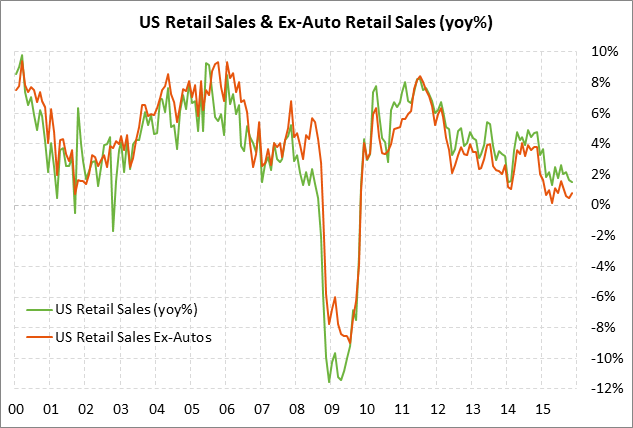- U.S. consumer confidence index expected to recover part of the sharp Oct-Nov drop
- U.S. metropolitan home prices expected to show another solid increase
- 5-year T-note auction to yield near 1.72%
- Weekly EIA report expected to show another decline in U.S. crude oil inventories tied to year-end tax considerations
U.S. consumer confidence index expected to recover part of the sharp Oct-Nov drop — The market is expecting today’s Dec U.S. consumer confidence index from the Conference Board to show a +3.4 point gain to 93.8, reversing part of November’s sharp drop of -8.7 points to 90.4. The U.S. consumer confidence index posted a 10-month high of 102.6 in September but then fell in Oct-Nov by -12.2 points to post a 14-month low of 90.4 in November.
The U.S. consumer confidence index posted an 8-year high of 103.8 in January 2015 but has since been weak all year due to (1) the sharp sell-off in U.S. stocks in August that was tied in part to Chinese turmoil, (2) the recession in the U.S. petroleum industry, and (3) weakness in the U.S. manufacturing sector. However, U.S. consumer confidence remains underpinned by a slowly improving labor market, a fairly steady economy, the recovery in stock prices after the August correction, and low gasoline prices.
Even though U.S. consumer confidence remains in decent shape, U.S. consumers are not spending much money and are being cautious. Most of the money that consumers are saving on gasoline is going into savings or paying down debt. In fact, U.S. retail sales have risen by a total of only +0.2% over the last four reporting months (Aug-Nov) and retail sales on a year-on-year basis in November were at only +1.5% y/y, just +0.2 points above the 6-year low of 1.3% posted earlier this year in April. The consumer caution is not good for near-term GDP growth, but it is good for the long-term health of consumers and the longevity of the economic expansion.
U.S. metropolitan home prices expected to show another solid increase — The market is expecting today’s Oct S&P/CaseShiller Composite-20 home price index to show a solid gain of +0.60% m/m, adding to September’s gain of +0.61%. The CaseShiller index earlier this year fell by a total of -0.3% in April through July as metropolitan home prices temporarily sagged. However, the index then rose by a total of +0.7% in Aug-Sep and is expected to show a further +0.6% gain in today’s report for October, indicating that metropolitan home prices have regained some upside momentum.
The CaseShiller index has risen by a total of +31% from the 13-year low posted in Jan 2012, but must still rise by another +15% to match the record high posted in April 2006. The FHFA index, by contrast, reached a new record high in October, indicating that U.S. home prices are at record highs when considered across the country in big and small cities and rural areas.
The sharp 31% rise in the CaseShiller index has yet to cause U.S. home buyers to back off on buying homes. Still, it is unlikely that home prices will continue to rise at the sharp rate seen in the past several years since potential home buyers will become increasingly resistant to higher prices as prices move higher.
5-year T-note auction to yield near 1.72% — The Treasury today will sell $35 billion of 5-year T-notes. The Treasury will then conclude this week’s $90 billion T-note package by selling $29 billion of 7-year T-notes on Wednesday. The benchmark 5-year T-note late yesterday closed at 1.72%, which translates to an inflation-adjusted yield of 0.49% against the 5-year inflation breakeven inflation expectations rate of 1.23%.
The 12-auction averages for the 5-year are as follows: 2.47 bid cover ratio, $43 million in non-competitive bids, 3.6 bp tail to the median yield, 11.7 bp tail to the low yield, and 45% taken at the high yield. The 5-year T-note is the second most popular coupon security among foreign investors and central banks behind the 10-year TIPS. Indirect bidders, a proxy for foreign buyers, have taken an average of 59.2% of the last twelve 5-year T-note auctions, which is well above the average of 54.7% for all recent Treasury coupon auctions.
Weekly EIA report expected to show another decline in U.S. crude oil inventories tied to year-end tax considerations — The market consensus is for Wednesday’s weekly EIA report to show a -2.25 million bbl decline in U.S. crude oil inventories, a +250,000 bbl rise in gasoline inventories, a +750,000 bbl rise in distillate inventories, and a +0.2 point increase in the refinery utilization rate to 91.5%.
Crude oil prices last Wednesday rallied sharply after the EIA reported that U.S. crude oil inventories fell sharply by -5.9 million bbls (-1.2%), more than offsetting the previous week’s rise of +4.8 million bbls (+1.0%). However, the bullish reaction to last week’s EIA report was mainly just year-end short-covering since the decline in oil inventories was due mainly to oil companies cutting their inventories at year-end to minimize taxes, as opposed to any fundamental decline in the oil glut. Even after last week’s decline, U.S. oil inventories were still a massive +35.1% (126 million bbls) above the 5-year seasonal average. Meanwhile, gasoline inventories are close to neutral at -0.2% below average. Distillate inventories are ample at +15.1% above average.





